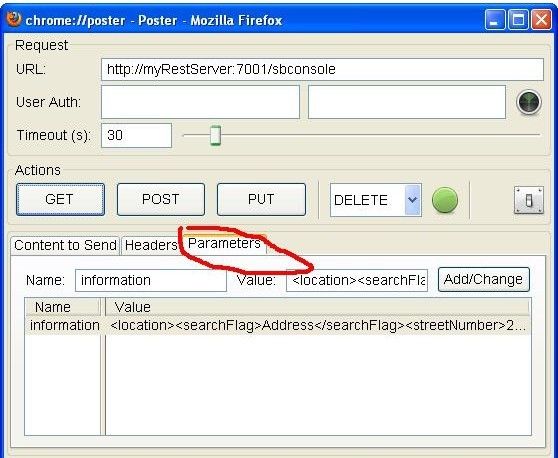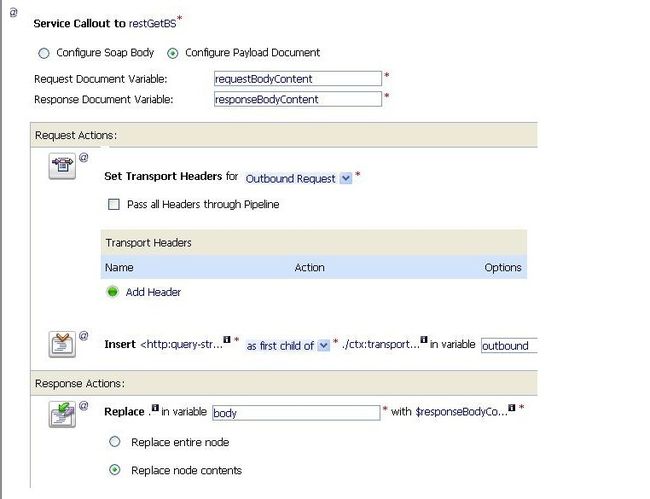OSB: Hooking up Rest Service with XML Payload in Query String
Using OSB to hook up Rest Service is fairly common. There are quite a few articles online talking about how to do it. However, I ran into some particular issues where trying to hook up a Rest Service in OSB. The problem is this service uses query string with XML payload. I had to jump through many hoops to get it to work. This post shows how I did it.
Assume the example Rest Service URL is “http://myRestServer:7001/sbconsole “ , this service takes a query string variable "information", the payload looks like
<location><searchFlag>Address</searchFlag><streetNumber>200</streetNumber><streetName>Water St</streetName></location>
Test Rest Service Directly
When I use Firefox poster to test the Rest service, it works fine. I can see Firefox sends up:
“GET /sbconsole?information=%3Clocation%3E%3CsearchFlag%3EAddress%3C%2FsearchFlag%3E%3CstreetNumber%3E200%3C%2FstreetNumber%3E%3CstreetName%3EWater%20St%3C%2FstreetName%3E%3C%2Flocation%3E HTTP/1.1
Host: myrestserver:7001”
Please note that the actual query string is URL encoded. As you will see, this will cause a couple of issues with OSB.
Business Service
If you pay close attention, you will see the only difference is that Firefox encodes “Water St” as “Water%20St”, whereas OSB encodes it as “Water+St”.
To the best of my knowledge, both are supposed to be “correct”. But our test Rest Service runs on IIS, it appears to me that IIS does not filter “+” inside the actual data element.
I couldn’t make OSB to encode space as “%20”. I suspect it goes to the Java API “URLEncoder”. According to the API (http://download.oracle.com/javase/6/docs/api/java/net/URLEncoder.html):
The space character " " is converted into a plus sign "+".
So I had to ask the Rest Service developer to filter “+” inside the code. That solves this part of the problem.
As a side note: IIS does filter “+” sign between element tags, just not inside the actual element data. I also suspect there may be a way to tweak IIS to filter “+” sign inside the element data. But I don’t know how if it really can work that way.
Proxy Service
With proxy service, when I call the Business service, I need to pass in “query-string” in HTTP header. However, if I pass in the payload directly, the Proxy service will encode the query string first. When the business service gets the string, it becomes garbled up, and the call will fail.
In order to pass in thIn order to pass in the query string to Business service, I need to escape the special characters like below:
<http:query-string>information=<location><searchFlag>{$body/typ:AddressValidatorRequest/typ:location/typ:searchFlag/text()}</searchFlag><streetNumber>{$body/typ:AddressValidatorRequest/typ:location/typ:streetNumber/text()}</streetNumber><streetName>{$body/typ:AddressValidatorRequest/typ:location/typ:streetName/text()}</streetName></location></http:query-string>
Conclusion
If there is an option to choose what method to use for the Rest service, my recommendation is to use POST, instead of query string (GET), especially if the Rest Service is expecting an XML payload.
With POST method, data is passed to the server as-is, no URL encoding is involved.
Source code
I don't know how to add attachment, so i'll just post the snippet of the source here:
<con:pipeline name="PipelinePairNode1_request" type="request" xmlns:con="http://www.bea.com/wli/sb/pipeline/config">
<con:stage name="stage1">
<con:context>
<con1:varNsDecl prefix="typ" namespace="http://www.lasvegasnevada.gov/GisAddressValidator/types" xmlns:con1="http://www.bea.com/wli/sb/stages/config"/>
</con:context>
<con:actions>
<con:wsCallout xmlns:con="http://www.bea.com/wli/sb/stages/transform/config">
<con1:id xmlns:con1="http://www.bea.com/wli/sb/stages/config">_ActionId-8515072324608930629--ca66017.12fdc6a1a2e.-7fe8</con1:id>
<con:service ref="myRestTest/restGetBS" xsi:type="ref:BusinessServiceRef" xmlns:ref="http://www.bea.com/wli/sb/reference"/>
<con:request>
<con:payload wrapped="false">$requestBodyContent</con:payload>
</con:request>
<con:response>
<con:payload wrapped="false">responseBodyContent</con:payload>
</con:response>
<con:requestTransform>
<con:transport-headers copy-all="false">
<con1:id xmlns:con1="http://www.bea.com/wli/sb/stages/config">_ActionId-8515072324608930629--ca66017.12fdc6a1a2e.-7fe7</con1:id>
<con:header-set>outbound-request</con:header-set>
</con:transport-headers>
<con:insert varName="outbound">
<con1:id xmlns:con1="http://www.bea.com/wli/sb/stages/config">_ActionId-8515072324608930629--ca66017.12fdc6a1a2e.-7fe5</con1:id>
<con:location>
<con:xpathText xmlns:con="http://www.bea.com/wli/sb/stages/config">./ctx:transport/ctx:request</con:xpathText>
</con:location>
<con:where>first-child</con:where>
<con:expr>
<con:xqueryText xmlns:con="http://www.bea.com/wli/sb/stages/config"><![CDATA[<http:query-string>information=<location><searchFlag>{$body/typ:AddressValidatorRequest/typ:location/typ:searchFlag/text()}</searchFlag><streetNumber>{$body/typ:AddressValidatorRequest/typ:location/typ:streetNumber/text()}</streetNumber><streetName>{$body/typ:AddressValidatorRequest/typ:location/typ:streetName/text()}</streetName></location></http:query-string>]]></con:xqueryText>
</con:expr>
</con:insert>
</con:requestTransform>
<con:responseTransform>
<con:replace varName="body" contents-only="true">
<con1:id xmlns:con1="http://www.bea.com/wli/sb/stages/config">_ActionId-8515072324608930629--ca66017.12fdc6a1a2e.-7fe4</con1:id>
<con:location>
<con:xpathText xmlns:con="http://www.bea.com/wli/sb/stages/config">.</con:xpathText>
</con:location>
<con:expr>
<con:xqueryText xmlns:con="http://www.bea.com/wli/sb/stages/config">$responseBodyContent</con:xqueryText>
</con:expr>
</con:replace>
</con:responseTransform>
</con:wsCallout>
</con:actions>
</con:stage>
</con:pipeline>
Tcpdump
In case you wonder how I captured my tcp packet, here is my sample command
/usr/sbin/tcpdump src 10.128.8.108 or dst 10.128.8.108 -nnvvXSs 1514 -w dump.cap


